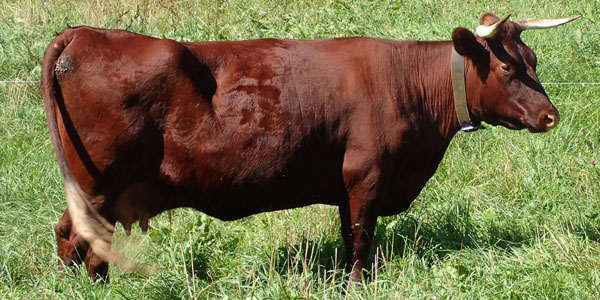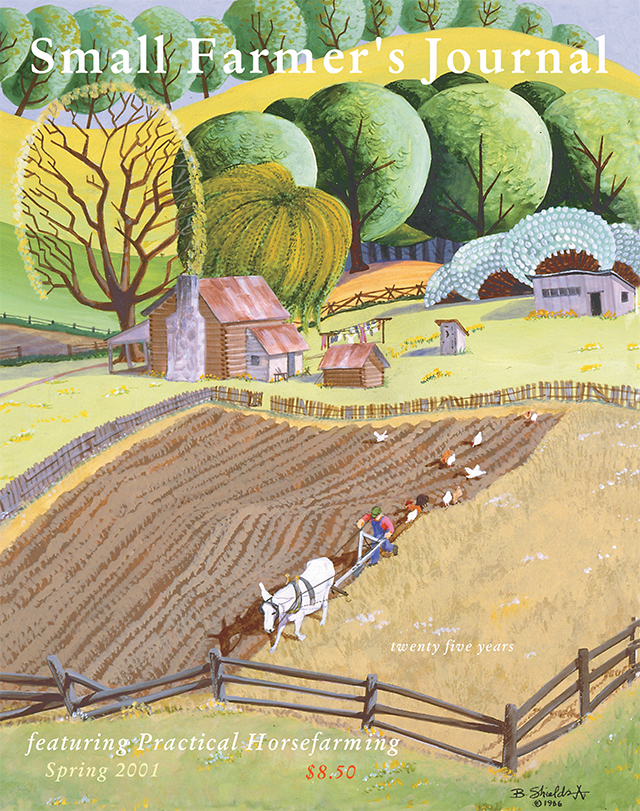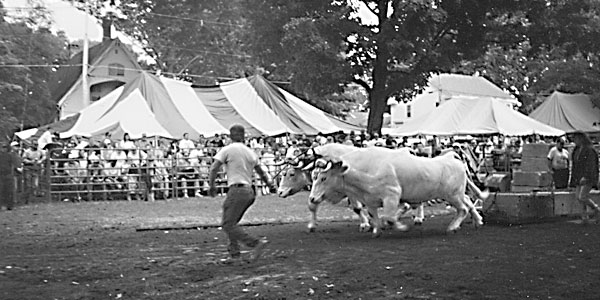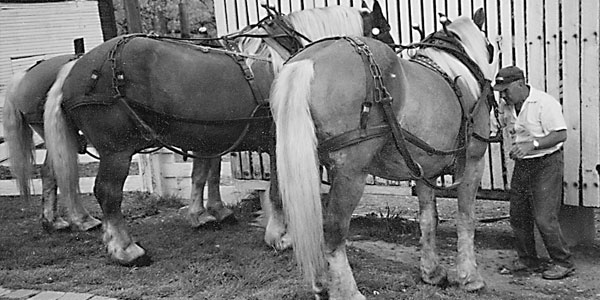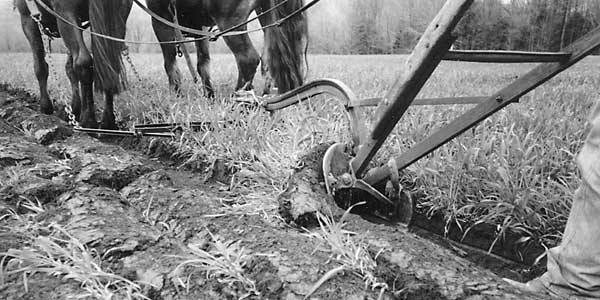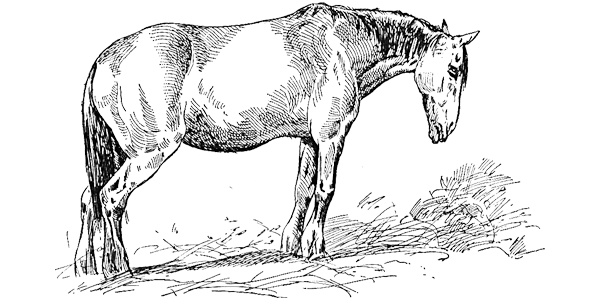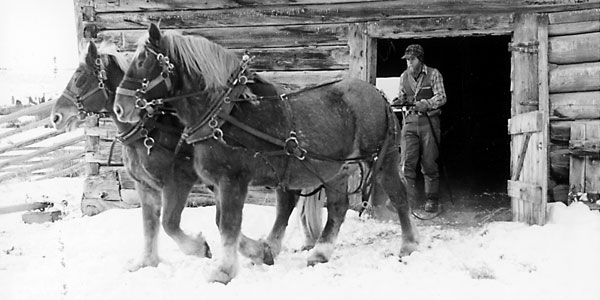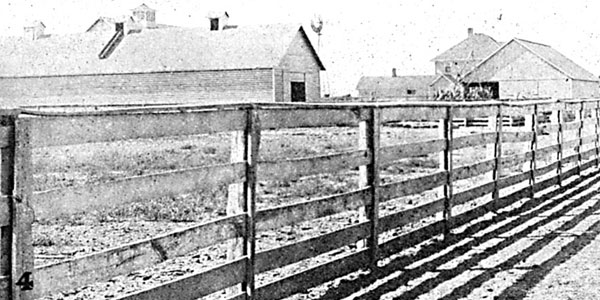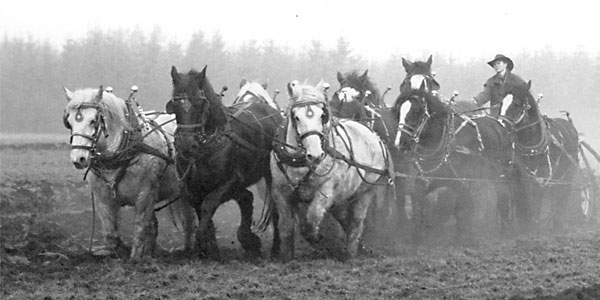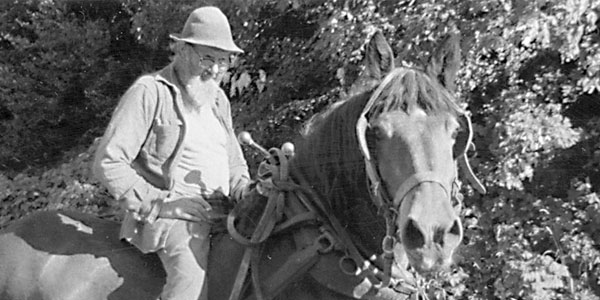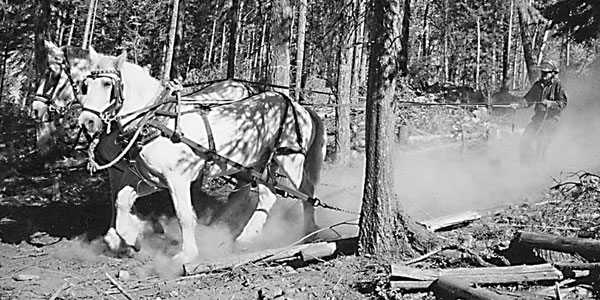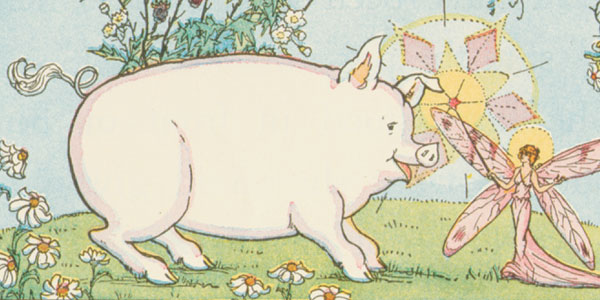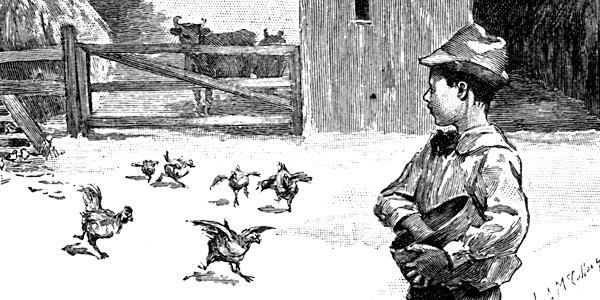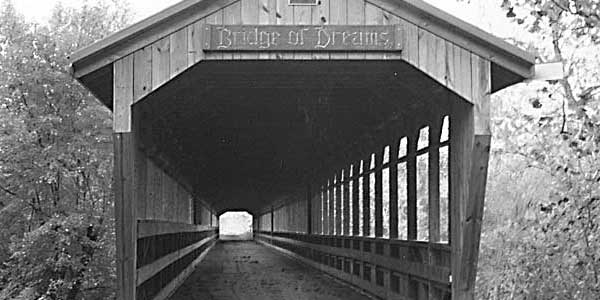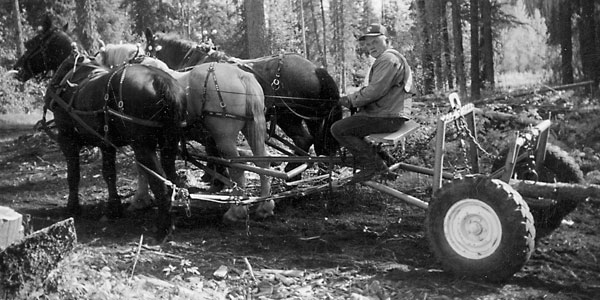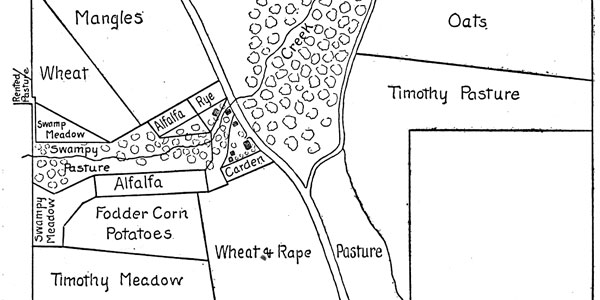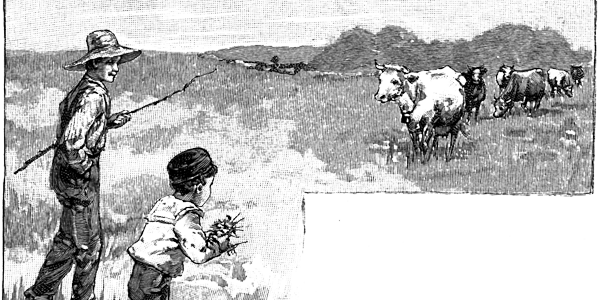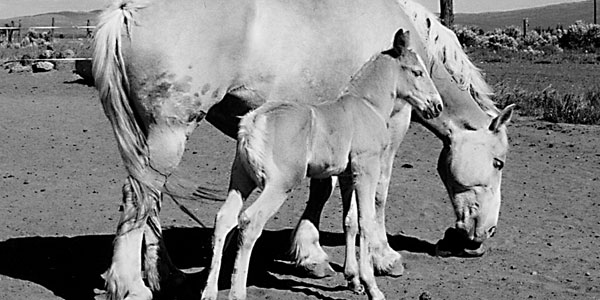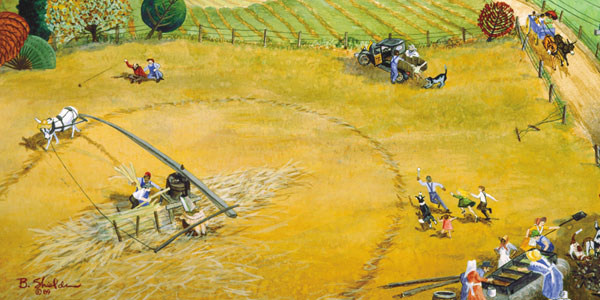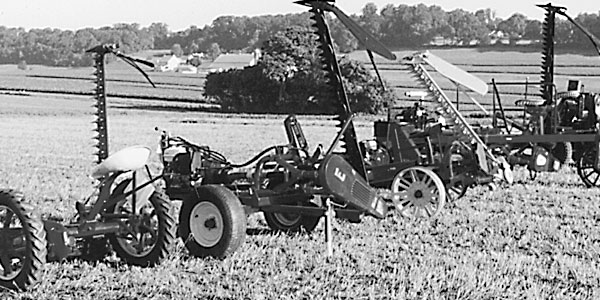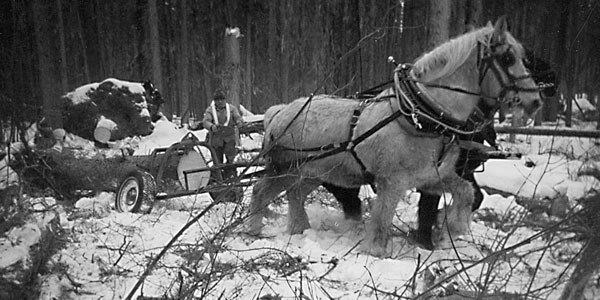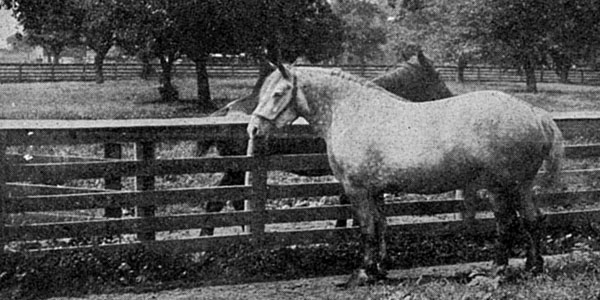Back Issue Vol: 25-2
A Horse for Laura and Ryan
Dr. Mark and their mother Becky had recently bought a home in Spokane that was situated on five acres and had a barn. The previous owner had to move away, but couldn’t take his horse. It would be theirs if they wanted it. Laura’s daddy hadn’t told her about the horse until he had talked it over with Becky and they had decided they would keep it. Now the secret was out. Dr. Mark would learn to ride and care for the horse and would teach the children as he learned. It would be fun and recreation for the whole family.
An Uncommon Common
As a great way to finish off the century, Clyde Keyes had the idea to compete horses and oxen against each other, the same day at the same fair, in the same drawing ring. Clyde is well known throughout New England and beyond as an organizer and announcer of such events. He also had his own team of horses 42 years ago. He’s now planning retirement and thought this competition would be a unique way to highlight his career. The teams of heavyweight horses were already scheduled to attend so Clyde arranged for six teams of powerful oxen to be on hand.
Blackberry
The first Blackberry introduced into cultivation was the Dorchester, which was exhibited before the Massachusetts Horticultural Society in 1841. This was followed by the Lawton a few years later, which became much more prominent. The Kittatinny soon divided honors with this, and both now largely have given place to the Snyder, which is undoubtedly the most widely grown variety of the present day. The rapid strides made by the Blackberry in cultivation prove that a place was ready and waiting for it in the pomological world, owing both to its desirable qualities in general and to its ability to rapidly vary and develop new types. At the present time (1902) it is one of the most important, most generally liked and most profitable bush-fruits grown.
Bob Schall, Plumcreek Horsefarmer
Farms and families who have worked them for generations are the essence of Armstrong County. Most of our farmers turn to modern technology to lighten the workload a bit, but some, such as Bob Schall, choose to farm using the methods of their ancestors. Schall lives and works on the 70-acre farm in Plumcreek Township that his father, Roy, purchased in 1959. And even though he still has the tractor his father bought, also in the 50’s, Schall prefers to work the fields of his farm with his Belgian draft horses.
Cultivating Questions: Preparing the Orchard Site
We plowed up a narrow contour strip wrapping around the south side of the market garden with the idea of eventually expanding production. Since the east end of this field seemed too steep and stony for vegetables, we decided that this site would be more suitable for a small orchard. Although we had no experience managing fruit trees, we were inspired to plant enough apples to meet our own needs after seeing Soil Conservation photos from the 1930’s which indicated a well established orchard on this same sidehill site.
Cultivating Questions: Rotational Cover Cropping in the Small Fruit Orchard
Cane fruit are among the most moisture demanding crops in the market garden. So, if irrigation is not available, it is essential that the cover crops grown between the rows do not compete with the berries for moisture. For example, a cover crop of oats and Canadian field peas planted right after the harvest of summer bearing raspberries would not compete with the cane fruit during the main growth and fruiting period.
EPM: A Frustrating Disease for Horse Owners
The clinical signs of EPM vary widely among horses. This is because the protozoa can cause damage at various locations in the CNS. The most common signs are: incoordination, weakness, muscle atrophy, and cranial nerve damage. The incoordination and weakness, characteristic of spinal cord disease, are common findings in horses with this disease. The signs involve only one side of the body. Many times what is seen is a weak spastic, swaying, and possibly stumbling gait. Horses can exhibit what appears to be a low-grade lameness. In severe cases, the horses may fall and are unable to get up. The muscle atrophy associated with EPM is not symmetrical and is most apparent over the hindquarters. Cranial nerve damage is manifested by facial paralysis, drooping ear, lazy eyelid, head tilt, and difficulty eating and drinking. Horses with EPM appear bright and alert with no fever. They have a normal appetite, even though they may have problems eating.
Feeding Elk: Winter Work for the Belgians
Doug Strike of rural Sublette County is spending his second winter feeding wild elk in nearby Bondurant, Wyoming. Strike is supplementing his logging income as well as helping his team of Belgian draft horses to keep in shape for the coming season. From May to the end of November he uses his horses to skid logs out of the mountains of western Wyoming. I found the use of Doug’s beautiful Belgian team an exciting example of appropriate technology.
Fencing the Farm
Fencing the farm is to a large extent a problem in farm organization. The amount of fencing required on a livestock farm is determined largely by the farm layout–the location of the farmstead, the arrangement of the field system, and the location and extent of the permanent pasture areas. The character of the fencing required will be determined very largely by the kinds of livestock kept. Horses, cattle, sheep, swine, and poultry all have somewhat different fencing requirements.
Happ’s Plowing: A Chance to Share
Dinnertime rolled around before we could get people and horses off the field so that results of judging could be announced. I learned a lot that day, one thing being that people were there to share; not many took the competition side of the competition very seriously. Don Anderson of Toledo, WA was our judge — with a tough job handed to him. Everyone was helping each other so he had to really stay on his toes to know who had done what on the various plots.
Hermits & Harbingers
Marvin Haskell was a jovial engaging disjointed hermit. A crippled old wizened yet well-fed curmudgeon who lived a mile up the road on his 300 acre timber/former dairy farm. In a tar-paper-covered single-wall fourteen by sixteen foot one room tool shed of a shack with no running water.
Horselogging Follies – Dance ’til you Drop
If you have ever had a few good days in the woods with your team – those days when you and the horses are right on top of the work, in great physical shape, and the wood piles up on your landing – then you may have thought, “this would be a great way to make a living. I should get a contract on a big chunk of timber.” After all, the opportunities abound: often private landowners want only horses to work in their woods, for reasons both philosophical and practical; forest companies will sometimes look for competent horseloggers to work in niche areas, as much for the public relations value as for silvicultural reasons; governments offer public timber sales with horselogging only restrictions; and I have detailed elsewhere (see SFJ Summer ‘94) how well a portable mill and a team of horses can work together.
Losing a Farm
When we finally accepted the fact that we would have to leave our home, we half-heartedly began our search for a new one by reading the want ads for rental possibilities. We had decided that we needed to be within 20 miles of the small city near which we lived or our marketing would be severely impeded. We didn’t find a single farm to rent and even the so-called “country” places had modern houses and very little land to go with them. We realized our only option was to buy a place although we didn’t know where we would get the money.
Maple Fest 2000
Years ago all sap was gathered from the buckets on the trees and poured into wooden tanks on sleds pulled by oxen or horses. Nowadays many farms use tractors; however, there are still quite a few places where animals are preferred. To honor that tradition the Meachams have invited members of the Western Mass. 4-H Ox Teamsters Association to be on hand for the day. Those who could come are here with their steers and carts giving rides around the farm. As we sink into the hay cushion in our cart we get the feeling of warmth even though we see not only our breath in the breeze but also the breath of each yoked animal.
Ohio Haflingers Fall Ride and Drive Over the Bridge of Dreams
The drive culminated on the “Bridge of Dreams,” the 370 foot long trestle on the old Pennsylvania Rail Road right of way that is now part of the Mohican Nature Trail from Danville to Fredericksburg. This trail from Danville is gravel and horse and wagon accessible. Although not opened all the way to Fredericksburg yet, the trail is open past Brinkhaven and over the second longest covered bridge in the country, the “Bridge of Dreams” that was dedicated in April of 1999.
Ole’s Log Building and Horse Logging
The students learned to skid in an open field to gain confidence in handling the horses. No one had handled draft horses previously. To start with, when a horse turned his head, the students would jump back. The students learned to drive first, then skid a log in the open. Stakes were set up in different patterns for them to skid a log through. Then they were taken into the bush to learn skidding. One student said, “You don’t expect us to skid a log in there do you?” Ole asked him where he thought he would be skidding logs from. This student became one of the best skidders.
Planning the Fields circa 1900
This information appeared in L.H. Bailey’s Cyclopedia of American Agriculture from 1900. It was one approach to field design at a time when rotation was king. Though the menu of crop succession is important and useful, we find the sterile approach to field reshaping, in the name of “efficiency,” to be harsh and somewhat suspect. With the return of our small farms and good farming comes a renewed interest in the powerful tool of crop rotation. It preserves soil, builds soil, activates the calendar year in helpful ways and spreads the farmer’s risk.
Sam’s Reckoning
As he made his way, dust swept itself through the woods, engulfing everything in its path. Sam’s eyes burned and his throat ached with dryness, but he pushed on, calling for the calf. He strained his eyes to see through the trees, looking for the black and white heifer. His heart thumping, Sam broke through a thorny bush and entered the clearing. He looked at the specks of blood forming on his hands, and then he looked up. The calf was standing near the canyon edge, bawling.
Sugaring the Old Time Way
In the Spring of 1997 we got a notion to do a little syrup making. We had done a little sugaring with our neighbor back in 1992 or 1993, can’t remember. But anyway, we used a cast-iron kettle over a fire. Needless to say it was slow. So when 1997 came on the scene, we figured it was about time to have some more of that tasty homemade stuff, so we made us a little nicer setup.
The American Cream Draft Horse
The American Cream Draft is finally holding its own in the world of horses. It does not really matter if you have an eye for the original farm style draft, the tall and lean hitch style draft, or something in between, I believe most horsemen with a discerning eye will embrace America’s own draft breed with the same appreciation the true draft horseman of the Midwest did in the 20’s and 30’s.
The Art of Bonnie Shields
Bonnie Shields is a living legend in western art circles. And Bonnie is a legendary human being to any and everyone she has touched. She is perhaps most famous for her humorous portraits of mules and her beloved LeRoy in particular but anyone who knows her knows of her phenomenal depth and range. It is her seasonal paintings of spring plowing which grace the cover of this issue. She illustrated an entire year with a different image depicting each month, a series which is powerful in its design and anecdotal energy.
The Mechanics of Farming
Next came the haying accoutrements. Any self-respecting tractor (not to mention tractor owner) needs lots of these – front parts, back parts, parts to pull, parts to push… the list is endless. And over the following months our farmyard began to look like a used machinery lot. First Jim bought a couple of extras for the tractor: a frontend loader (with eight ferocious teeth) and an auger for drilling holes. Oh, the bliss now of putting up fencing. Then came the big time spending on the haying “team.” After assiduous attendance at farm sales we managed to put together the whole shebang: mower, tedder, rake, and lastly, the grand old man of them all, the baler.
The Woods Betrayed
What of the squirrels, grouse, frogs, mice and fur bearing animals that call this home? They were betrayed by the ones who studied them, lived off them to either be trampled by the machines or try to find a new home as winter set in. Their food supply and homes are gone forever so may many of them be gone forever. What greed does to us!
Three Percheron Mares and the Men they Made
One day last fall, I fell in with a farmer wandering through the horse stables at the Illinois State Fair. Naturally enough we got to talking about the Percheron show. I was more anxious for an audience than anything else, and began unloading the story of the old mare in Virginia. I had no idea that I was talking to Dan Augstin. He lost no time in stating to me, in his own way, that bloodlines in Percherons have just as much significance as they do in Shorthorns, or any kind of purebred stock in which the pedigree goes back to Adam’s time. He took me to his stalls, and there told a story that dated back to the time of old Louis Napoleon, one of the first Percheron stallions ever brought to this country.
Why Not the Suffolk?
Horses of the breed have power out of all proportion to their weight. Even a casual glance at their make-up will furnish the reasons for their fame as tug-stretchers. They are short-legged and close to the ground; the center of gravity is low, in accordance with a well-known mechanical principle which the designer of any movable engine must keep constantly in mind. The scientists tell us that the power which moves the equine engine comes from the thick, short gluteal muscles. The Suffolk is unsurpassed in the turn of his rump, while his thighs and quarters are more massively furnished than those of any other breed, thanks to the pulling contests common in England.




